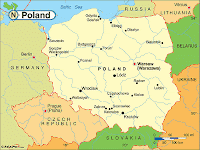 Cracow-Częstochowa Upland, Poland
Cracow-Częstochowa Upland, PolandSaturday, May 2, 2009
.
Castles of Jura
There is a holiday celebrated in Poland at the beginning of May every year. So because our Polish friends had a long weekend, it was decided that we would travel south together on Saturday to visit some castles and spend time together. So our family, Daniel and Ania and their family, Andrzej and Kasia and their family, and Mark and Naomi and their family visited four castles along the “Eagle’s Nest” trail. It doesn’t take very long to get to these castles, and we had a lovely time together. It was perfect weather for such a trip. We are trying, as best as we can, to include some history of the places we are visiting. So the rest of this post will include a brief history of the castles we visited, as well as pictures we took at the various locations. Also, please check out the map below of which castles on this “Eagle’s Nest” trail that we visited.
 .
.Jura is a popular name of the Cracow-Częstochowa Upland. The landscape of this area is formed by lime rocks, picturesque hills and Gothic castles. In the Middle Ages, the Upland was the Western rampart of the Polish Kingdom. That is the reason why so many castles and watch-towers were built along its’ borders. One of their founders was a Polish king Kazimierz Wielki (1333-1370). Royal strongholds included the castles of Będzin, Bobolice, Mirów, Ojców, Olsztyn and Pieskowa Skała. Other castles, among them Bydlin, Korzkiew, Lipowiec, Morsko, Pilica, Ogrodzieniec, Rabsztyn, Siewierz, Smoleń and Tenczyn were erected by representatives of the powerful noble houses and the clergy. Their days of splendor and military importance came to a close with the Swedish deluge (1655-1660). The Swedish invaders destroyed nearly all local fortresses. In 1857 Wiktor Zieliński, a poet and sightseer, amazed at the beauty of the Castles of Jura, called them Eagle’s Nests.

.
Olsztyn Castle
Olsztyn Castle was erected by the king Kazimierz Wielki in the 14th century. During it’s history it was besieged by the forces of Archduke Maximillian von Habsburg (1587) and the Swedish invaders (1656). In the 1990’s the castle won it’s fame for an open-air event: fireworks and a laser show. The surroundings of the castle were a set for Polish films: “Manuscript Found in Saragossa” by W. Has and “Demons of War” by W. Pasikowski. Now it belongs to the Olsztyn commune.
.
Mirów Castle
Mirów Castle was built by the king Kazimierz Wielki. Later it was in the hands of noble families: the Kozieglowskis, the Myszkowskis, the Korycińskis and the Męcińskis. In 1587 the castle was seized by the troops of Archduke Maximillian von Habsburg, and in 1657 it was seriously damaged by the Swedish invaders. In 2006 the fortress was bought by two brothers, Dariusz and Jarosław Lasecki, who also own the nearby Bobolice Castle.
.
Bobloice Castle
Boblice Castle erected by the king Kazmierz Wielki, dates back to the middle of the 14th century. In later years it was owned by such families as Szafraniec, Męciński and Myszkowski. In 1587 the castle was conquered by the troops of Archduke Maximillian von Habsburg and in 1657 seized by the Swedish troops. In 1999 it was bought by two brothers, Dariusz and Jarosław Lasecki.
.
Ogrodzieniec Castle
Ogrodzieniec Castle erected in the 14th century, is one of the most picturesque castle ruins in Poland. Centuries ago it was possessed by different families, such as Włodek, Salomonowicz or Boner. Twice in it’s history the fortress was seized and destroyed by the Swedes (1655 and 1702). Since 1995 it has been managed by Zamek Ltd., Ogrodzieniec.
.
Christian Young













No comments:
Post a Comment